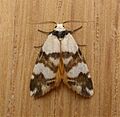List of moths of Australia facts for kids
Australian moths are amazing insects! Australia is home to between 20,000 and 30,000 different kinds of moths. That's a huge number, especially when you compare it to the 400 types of Australian butterflies.
Moths and butterflies are actually part of the same scientific group called Lepidoptera. Moths are usually active at night (they are nocturnal), while butterflies mostly fly during the day (they are diurnal). Scientists group these moths into about 80 main families. This helps them understand and study all the different types.
This page gives you a look at some of the many moth species found in Australia. This includes the main continent, Tasmania, and nearby islands.
Understanding Moth Families
When scientists talk about "families" of moths, they are grouping similar types of moths together. It's like how your last name groups you with your relatives. Each family has its own special features. Sometimes, a moth family is only found in Australia; this is called being endemic.
Here are some of the interesting moth families found in Australia:
- Adelidae
- Agathiphagidae
- Agonoxenidae
- Alucitidae
- Anomosetidae
- Anthelidae
- Arctiidae
- Argyresthiidae (often seen as a subgroup of Yponomeutidae)
- Arrhenophanidae
- Batrachedridae
- Blastobasidae
- Blastodacnidae (sometimes part of Agonoxenidae)
- Bombycidae
- Brachodidae
- Bucculatricidae
- Carposinidae
- Carthaeidae
- Castniidae
- Choreutidae
- Coleophoridae
- Copromorphidae
- Cosmopterigidae
- Cossidae
- Cyclotornidae
- Depressariidae (often seen as a subgroup of Oecophoridae)
- Drepanidae
- Douglasiidae
- Dudgeoneidae
- Elachistidae
- Epermeniidae
- Epipyropidae
- Erebidae
- Eriocottidae
- Ethmiidae
- Eupterotidae
- Galacticidae
- Gelechiidae
- Geometridae
- Glyphipterigidae
- Gracillariidae
- Heliocosma group
- Heliodinidae
- Heliozelidae
- Hepialidae
- Herminiidae (often seen as a subgroup of Noctuidae)
- Hyblaeidae
- Hypertrophidae (often seen as a subgroup of Oecophoridae)
- Immidae
- Incurvariidae
- Lacturidae
- Lasiocampidae
- Lecithoceridae
- Limacodidae
- Lophocoronidae
- Lymantriidae
- Lyonetiidae
- Macropiratidae
- Micronoctuidae
- Micropterigidae
- Momphidae
- Nepticulidae
- Noctuidae (includes Aganaidae and Nolidae)
- Notodontidae
- Oecophoridae
- Oenosandridae
- Opostegidae
- Palaeosetidae
- Palaephatidae
- Plutellidae
- Psychidae
- Pterophoridae
- Pyralidae (includes Crambidae)
- Roeslerstammiidae
- Saturniidae
- Scythrididae
- Sesiidae
- Simaethistidae
- Sphingidae
- Symmocidae
- Thyrididae
- Tineidae
- Tineodidae
- Tortricidae
- Uraniidae
- Yponomeutidae
- Zygaenidae
Images for kids
See also






